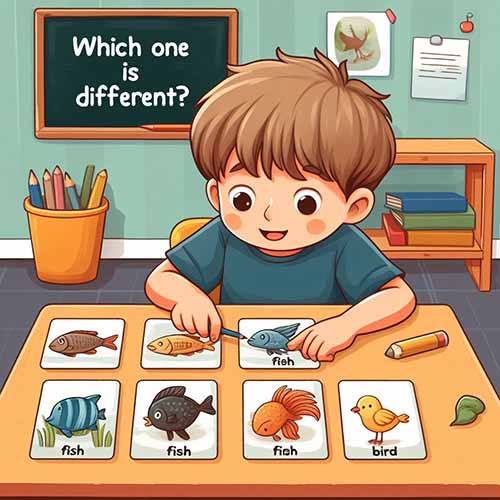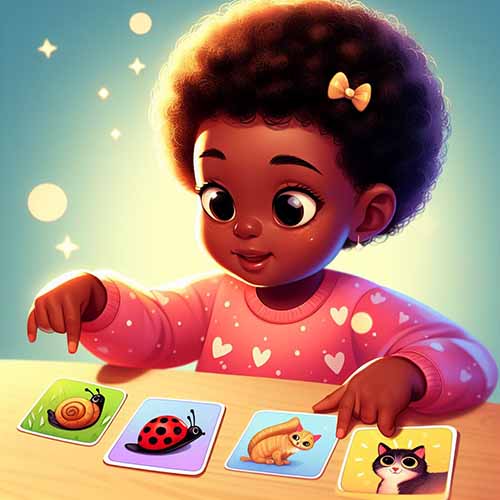Classifying Lesson Plans for Pre-K and Kindergarten: A Guide from MathSkills4Kids
-

Classroom enjoying classifying activity - By BING -
Classifying is a fundamental skill that helps students develop their logical thinking and problem-solving abilities. It also lays the foundation for more advanced math concepts such as sets, patterns, and data analysis.
This guide and the following lesson plans will show you how to use MathSkills4Kids videos to teach classifying fun and engagingly. You will also find web and YouTube video links for more examples and activities.
Introduction: What is classifying, and how does it relate to math learning?
Classifying is the process of grouping objects based on their similarities and differences. It helps students to organize their thinking, compare and contrast, and make sense of the world around them. Classifying also prepares students to learn numbers, shapes, patterns, measurements, and data.
-
CLASSIFYING
-
BROWSE THE LESSON PLANS
-
-
How to use MathSkills4Kids videos to engage students in classifying activities
MathSkills4Kids videos are short and interactive videos that introduce and demonstrate various math topics. They are designed to capture students' attention, stimulate their curiosity, and motivate them to learn.
You can use MathSkills4Kids videos to introduce classifying concepts, model classifying strategies, and provide examples of classifying tasks. You can also pause the videos at any point to ask questions, check understanding, or extend the learning.
READ FURTHER
-
Same and Different: How to help students identify similarities and differences among objects
One of the first steps in classifying is to help students recognize the similarities and differences among objects. You can use MathSkills4Kids videos such as "Which one is Different?" or “Which ones are exactly the same?” to introduce this concept. In these videos, students will learn how to compare objects and decide if they are the same or different based on their attributes, such as color, shape, size, etc.
You can follow up with activities such as:
- Show students two objects and ask them to name one way they are the same and one different.
- Give students a set of objects and ask them to find two objects that are the same or different in some way.
- Play an "I Spy" game where you describe an object using its attributes, and students have to find it.
-
Sorting by One Attribute: How to help students sort objects by color, shape, size, etc.
Sorting by one attribute is another essential skill in classifying. It helps students focus on one object's characteristic and ignore the others.
You can do activities such as:
- Give students a set of objects and ask them to sort them by one attribute of their choice.
- Give students a sorting mat or a chart with different categories and ask them to sort the objects accordingly.
- Play a "Guess My Rule" game where you sort some objects by a secret rule, and students must guess what it is.
-
Sorting by Two or More Attributes: How to help students sort objects by multiple criteria
Sorting by two or more attributes is a more advanced skill in classifying. It helps students to compare and contrast multiple characteristics of an object and create subgroups within groups.
You can do activities such as:
- Give students a set of objects and ask them to sort them by two or three attributes of their choice.
- Give students a Venn diagram or a Carroll diagram with different categories and ask them to sort the objects accordingly.
- Play a "What is Missing" game where you sort some objects by two or three attributes and remove one object. Students have to figure out which object is missing and where it belongs.
-
Classifying by Category: How to help students group objects by common characteristics
Classifying by category is another way of grouping objects based on common characteristics. It helps students to make connections between different objects and understand their relationships.
You can do activities such as:
- Give students a set of objects and ask them to classify them by category of their choice.
- Give students a category and ask them to name or find objects that belong to it.
- Play a game of "What Does Not Belong?" where you show students a group of objects and ask them to identify the one that does not belong to the category.
Conclusion: How to reinforce and evaluate classifying skills
Classifying is a skill that can be practiced and assessed in various ways. You can use the following methods to review and test classifying skills:
- Observing students' classifying strategies and behaviors during activities.
- Asking students to explain their classifying choices and rules verbally or in writing.
- Asking students to create their own classifying tasks or challenges for themselves or others.
-
We hope this guide has helped you to plan and implement effective classifying lesson plans for pre-k and kindergarten using MathSkills4Kids videos. For more math videos and resources, visit our website at https://mathskills4kids.com/.
Please CLICK THE SHARE BUTTON to allow others to benefit from this content!


